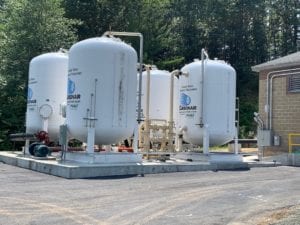Who is a member?
Our members are the local governments of Massachusetts and their elected and appointed leadership.

The new water filtration system at Chestnut Street Water Filtration Plant in Hudson. (Photo by Eric Ryder)
In anticipation of updated federal and state regulations regarding acceptable levels of PFAS (per- and polyfluoroalkyl substances) in drinking water, communities are updating their water filtration systems to improve safety.
Barnstable, part of the Hyannis Water System, is building a $12 million water filtration building, with help from the Department of Environmental Protection’s Drinking Water Program, which provides low-cost financing to help communities comply with regulations.
“We feel like this is really needed,” said Barnstable Public Works Director Daniel Santos. “We need the help from the state. These are expensive systems, and the burden will fall on ratepayers without [the state aid].”
Barnstable had installed a treatment system a few years ago, but this new, larger system is much more complex, Santos said.
“We were concerned that there would be a rush on these treatment systems and everyone will be waiting,” he said. “There is already a six-month lead time for equipment.”
The new system, expected to be completed in about a year, will use activated carbon, advanced oxidation with peroxide, and ultraviolet light to remove PFAS as well as a chemical compound called 1,4-Dioxane. The system will also remove manganese and iron using greensand filtration.
“Granulated activated carbon is very effective and very cost effective,” Santos said. “The PFAS is removed from the water and adheres to the carbon. The carbon is replaced as it builds up.”
Barnstable had to shut down two of its 12 wells a few years ago due to contamination that exceeded acceptable levels. The town has been buying water from Yarmouth since 2015 to meet demand, at a cost of about $1 million per year.
Further inland, the town of Hudson has installed a temporary system at its water treatment plant using resin-based filtration following a water sample test in January that exceeded the allowable PFAS levels of 70 parts per trillion. The system came online in July, and testing shows PFAS levels as non-detectable. The town is also installing a carbon-based filtration system at its Cranberry Bog Well.
The system, which cost around $1 million, used capital project funding that had been set aside for water system improvements. The language for the funding was changed at Town Meeting so it could be used for PFAS removal.
“The filtration vessels were one component,” said Public Works Director Eric Ryder, “but we had to look at how to adapt it to work with our current system, and there are a lot of moving parts. … To permit, bid and build a treatment facility would have taken years, so my staff did a lot of work in house to get this up and running.”
The resin used in the filtration system needs to be replaced annually, at a cost of about $230,000.
These new systems will treat the drinking water so that contaminants reach non-detectable levels, but they are not remediation solutions. Investigations are underway to determine the source, or sources, of the contaminants.
Earlier this year, the Department of Environmental Protection proposed revisions to the rules for drinking water standards that would bring the acceptable level of PFAS down from 70 parts per trillion to 20 parts per trillion. The department is also considering revisions to rules regarding cleanup of groundwater at contamination sites.
“With this field of emerging contaminants it’s only going to get more difficult,” Santos said. “It’s clear that standards are coming. Even though it’s a goal, we take the goal as the standard so we can plan and manage our system to get out ahead of it.”